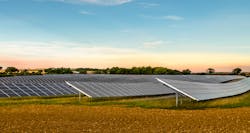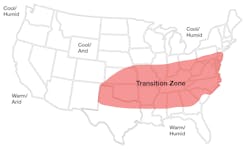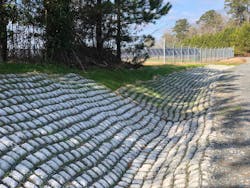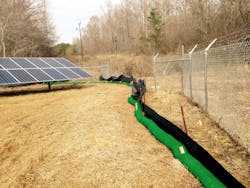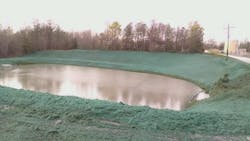What do a solar farm and a football field have in common? I often have this conversation with engineers and environmental stewards when talking about vegetation establishment in the Mid-Atlantic region of the United States. Most of the lower Mid-Atlantic and upper southeast is positioned in what’s known to turfgrass managers as the Transition Zone. It’s an area of the country where warm-season and cool-season grasses both grow and flourish at different times of the year.
Rural communities in the Mid-Atlantic, especially North Carolina and Virginia, have become a hotbed for solar development in recent years. This is due to a few factors. One is the availability of large tracts of open land, along with the ability to fit the energy produced into the overall grid. Another is a 2009 law from Virginia’s Department of Environmental Quality (DEQ) to develop “permit by rule” regulations for solar projects and other renewable energy, a much more transparent process. Several states in the Mid-Atlantic have created an environment conducive and inviting to solar developers. In addition, regional lawmakers have created orders calling for higher percentages of the state’s energy to come from renewable energy, creating a government incentive on increasing solar and wind for the public good.
What about football? Well, imagine your favorite college football team. Where is their home football field located in the US? What type of grass is on the playing surface of that field? If it’s in the northeast, the grass on the field is probably a cool-season grass such as Bluegrass, Fescue, and Perennial Ryegrass; these are all cultivars that survive and flourish in the Northeast United States. If your team is in Alabama or Texas, the playing field is most likely Bermuda grass, but lawns and golf courses in the area may also be zoysia or centipede. The climates for those two opposite ends of the US match the cultivars of grasses—cool season or warm season.
The Transition Zone, on the other hand, is an area where both warm-season and cool-season grasses can flourish, but at different times of the year. Cool-season grasses like fescue will perform well in the spring and fall but will be stressed in a hot humid summer. Warm-season grasses like Bermuda will thrive in the summer but go dormant in the winter. The Lawn Institute acknowledges this as “the most difficult zone in which to grow turfgrasses.” As a result, the turfgrass manager, whether at a football field, a county park, a solar farm—or even a homeowner—struggles with the dynamics of the Transition Zone.Granted, this is an oversimplification. Modern-day football fields are about an acre of manufactured soils with daily irrigation and structured drainage. In many ways, they are a world away from an 800-acre solar farm that needs to be vegetated. But realistically, the struggles of the turfgrass manager on a field and the seeding contractor on a solar farm can be similar. If I threw out challenges like weed pressures, too much or too little precipitation after planting time, and traffic wear, you could believe that I was talking about either location. Construction managers need to have an understanding of the Transition Zone to be successful in establishing vegetation and hindering erosion issues.
Reclamation Mixes versus Native Mixes
One of the best places to start with the seeding process is local state regulations, either with the Department of Transportation or the state’s environmental agency. In Virginia, where I live, it’s the Virginia Sediment and Erosion Control Handbook, provided by the DEQ. It breaks the state down by region and gives seeding recommendations for general and steep slopes based on gradation. There’s a nurse crop recommendation based on the time of the year you are planting. Nurse crops are annual cultivars meant to hold the soil while slower species fully grow in, and they also grow a bit taller and provide some shade for other cultivars. In Virginia, this mix might be a combination of fescue and red top, with a smaller per acre rate of a nurse crop like millet in the summer and rye grain in the winter.
SoilDEFENDER is a reclamation mix used on job sites throughout the mid-Atlantic. It provides an aggressive stand of vegetation on common areas, slopes, and in the solar array areas around panels. Ronnie Guthrie is president of RSG Landscaping & Lawn Care, who works on job sites around the mid-Atlantic. “SoilDEFENDER has worked great for us,” he says. “We seed a lot of soils where the pH range is 5 to 5.5. We have had great germination and establishment. I like that the mixture has seed types which work well whether you are seeding slopes or flat areas. It germinates quickly to hold and stabilize soil. The fescues and clovers help to fill in areas and put nitrogen back in the soil that is needed for future growth.”
Many people use the term “reclamation mix” and “native mix” interchangeably. It’s important to understand the difference. While we’ve spoken of the benefits of reclamation mixes for erosion control, native mixes can be used in numerous places on a solar farm or any job site.
Native mixes are often described in the name itself, with varieties in the mix being either native grasses or forbs. Native seed companies do well when putting together mixes specific to an area by including ecotypes specific to states. These mixes are often generally put into one of three categories: upland, lowland, and wetland, with their names indicative of their usages on job sites. Natives provide numerous benefits to solar sites; they bring back original habitats, which are great for pollinators like butterflies, bees, insects and songbirds.
Native seed mixes are used all over North America with success. That said, their use at solar facilities in the Mid-Atlantic US and the rest of the Transition Zone does not come without challenges. Many native seed mixes take 3 to 5 years until full vegetation has established. Weed pressure can overtake a job site in the transition zone in one summer, drastically reducing the germination and survivability of natives. There are herbicides that can be used in conjunction with native mixes, but many specifications of natives from various engineering groups and state regulators discourage the use of herbicides on natives.
Jon Straughn, president of Chesapeake Valley Seed, headquartered Maryland, has been on the frontline of these challenges for years. “If you need rapid grow-in for erosion control, a reclamation mix is what you need. Natives have a much longer establishment window that could lead to erosion issues, especially on steeper slopes,” he explains.
Sitework and Sediment Control
Further challenges on solar sites revolve around sediment control during construction or rain events. Spring and early summer, ideal times for seeding, is a time of varying rain events, and when they do come, they are often torrential downpours. Even coastal areas in the Mid-Atlantic that are relatively flat can end up with mild gradient slopes as a result of grading plans, creating challenges when it comes to managing erosion.
Many large acreage solar sites are divided up into tabletop pods—relatively flat areas graded out for solar arrays. While the gradient on these areas is minimal, they’re not without concentrated sheet flow that can cause problems and rill erosion as these “pods” merge back into normal terrain.
Compost filter socks, like SiltSoxx by Filtrexx, have long been used in perimeter control but they are also great for slope interruption. Compost filter socks can be placed throughout these graded areas to slow down and capture sediment as well as to slow sheet flow, thus minimizing erosion. SiltSoxx have also been installed underneath fixed solar panels that don’t rotate to the sun, running parallel to the rows of panels so that rainfall coming off panels is dissipated and constant water flow off the panel isn’t an issue during construction.
Sediment basins are often used for large solar job sites, and their top and side slopes are perfect areas for reclamation mixes. They are sometimes steep enough that vegetative establishment can be challenging, especially with large rainfalls. In those instances, hydroseeding these areas with a Bonded Fiber Matrix (BFM) or a Flexible Growth Medium (FGM) is a great option. Flexterra is a high-performance FGM manufactured by Profile Products.
“Flexterra provides a mechanical bond with the soil, it’s an immediate erosion control measure,” explains Melanie Fuhrman, market development manager for Profile Products. “It can be used in general seeding practices, but is effective on extremes slopes with a 2:1 gradient.” While solar arrays are often flat enough to be economically seeded by way of more traditional means like a spreader or drill seeder, don’t overlook the option of hydroseeding more challenging areas in the overall scheme of the project.
Specifications Value Engineered On-Site
Solar sites in the Mid-Atlantic have challenges above and beyond vegetative establishment. Large job sites often have a specification for rip-rap usage due to a lack of alternatives. A 5000 psi Tied Concrete Block Mat system, Flexamat can be used in place of rip-rap, with higher shear stress based on ASTM 6460 standards. It can be vegetated and used in channels under pipe outfalls, on damn or sediment pond spillways, and on roadside ditches.
In addition, Flexamat can be used as a drivable surface, withstanding the weight of an 80,000-pound vehicle. It can be used as a vegetated driving surface but is often infilled with crushed stone. On solar sites, this application is used for lay down yards in areas of poor soil or parking sites at job site trailers. Another prominent use for this product in solar is at low water crossings. “We work with engineers on a daily basis in the specification phase of projects,” says Stallo, “but we often work with engineers and contractors on-site to help value engineer challenging areas where rip-rap might have traditionally been used.”
Energy sector job sites in the Transition Zone and the mid-Atlantic region present unique demands, based on both population and climate, but rural areas in the region that can create solar energy for the grid are becoming growth opportunities for the industry. While challenges may exist, effective erosion and sediment control measures can be engineered from the initial specification or determined during the construction phase as needed, creating a sustainable and efficient job site for the benefit of all involved stakeholders.
References
The Lawn Institute. “Cold & Warm Season Grasses.” www.thelawninstitute.org/pages/education/types-of-grasses-and-species-selection/cool-and-warm-season-grasses.
Virginia Department of Environmental Quality. “Development of Solar Energy Program in Virginia.” Accessed May 28, 2020. www.deq.virginia.gov/Programs/RenewableEnergy/SolarEnergy.aspx.
